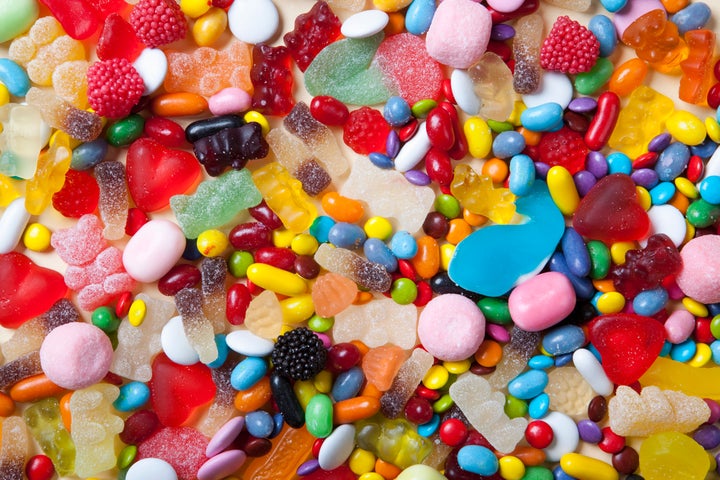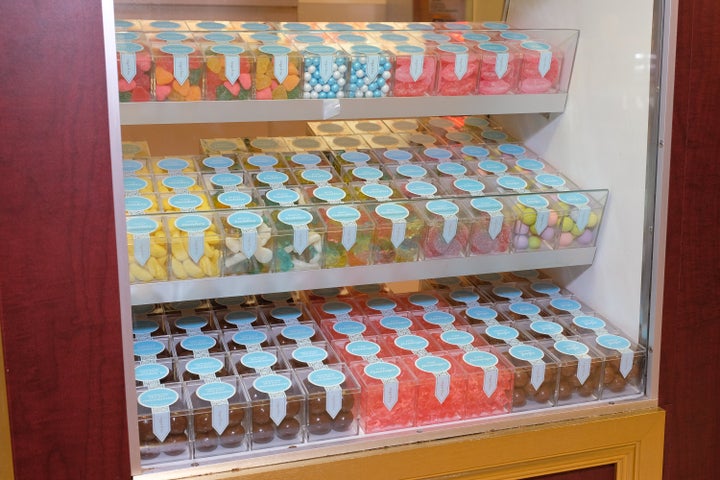
If you look at the candy aisle or checkout counter at your nearest supermarket, gas station or drugstore, you’ll see bags of Haribo gummy bears or sour Trolli worms for less than $2 per pack.
Meanwhile, luxury candy brands like Sugarfina are selling their gummies, sour candies and other indulgences for $8.50 to $20 a pack. But what accounts for that price jump? And are you really getting a superior ― or even different ― product?
HuffPost asked candy experts to explain the difference between the classic, cheap candy of our childhood and the higher-end offerings we see in department stores or at fancy events today. Read on for their breakdowns.
Packaging is a big part of it.
“I think the branding and the packaging is a huge part of the appeal of higher-end candies,” said Elizabeth LaBau, a confectioner and author of “The Sweet Book of Candy Making.”
“Unwrapping a ribbon and opening a beautiful box from Sugarfina feels like an event,” she added. “Tearing open a generic bag of candy just doesn’t have the same feeling of indulgence.”
Sugarfina and other upscale brands tend to offer chic packaging with visual impact, whether it’s by using trendy designs, customization for personalized gifts or overall luxury vibes. In many ways, they feel meant for gifting.
“I think if you were to take the candy out of the packaging, you’re talking about gummies and dragées and those kinds of things, which would be fairly similar to what you’re getting at the grocery checkout counter,” said Beth Kimmerle, a confectionery expert and author of “Candy: The Sweet History.” “But even if the candy might be super similar to a Jelly Belly, they package it in a way that’s very gift-able, and I think right there, that’s what you’re paying for.”
The candy itself may offer additional visual cues that suggest luxury, noted Susan Benjamin, a candy historian and president of True Treats Candy in Harpers Ferry, West Virginia.
“They have those pastel hues, but they’re not garish,” she explained. “So it may suggest it’s for people who are educated. When I was a communications strategist, I learned about these subconscious responses to packaging. Something like Sugarfina is fun but intelligent fun, sort of class-based for people with more refined taste.”
There are some ingredient differences.
But beyond the look of it, does expensive candy use different ingredients compared with cheap sweets? The answer is yes and no.
“When it comes to making candy, it’s really all about sugar and flavor,” Kimmerle explained. “So some of the nicer candies are going to be using the exact same kind of sugar you’d find in a grocery store candy, but maybe be flavored with something like a real fruit juice instead of an artificial flavor. Still, sugar is the bulk of what candy is, so some of those ‘higher end ingredients’ or flavor systems we’re talking about are a very small percentage of the candy.”
Sugarfina touts its premium ingredients and confections sourced from artisan candy makers around the world, as well as its dedication to keeping up with trends in luxury food and beverage and incorporating these flavors into the latest creations.
“Made with Champagne, our Champagne Bears sparkle in flavors of vintage Brut Champagne,” the brand’s CEO, Scott LaPorta, told HuffPost. “A new addition, our vegan collection of gummies, includes our Magic Mangos and Summer Strawberries, which are made with real fruit purée to give each bite a fresh, juicy flavor.”
High-end brands like Sugarfina and Squish often source ingredients from artisan candy makers across the globe, particularly in Europe, which can up the cost.
“When it comes to gummy and sour candies or licorice, a lot of them are made in Europe, where they have very different standards in regard to ingredients ― avoiding artificial or processed ingredients or using natural flavors and colors,” said Kelly “The Candyman” Jaime, owner of The Sweet Shop NYC.
Indeed, some people may lean toward luxury candies because they contain more fair trade or seemingly high-quality ingredients. Maria Sharapova’s brand Sugarpova describes its candy as “packed with antioxidants and made from natural, non-GMO ingredients.”

“With brands like Sugarfina or Sugarpova, they do take a lot of care in the marketing and branding of their products as well as sourcing premium, sustainable ingredients, which the more privileged consumer can afford and will buy. Whether it’s to ease their conscience or impress friends at a dinner party or social gathering is another matter,” said Anthony Myers, editor of confectionerynews.com.
Artisan production requires more money.
As noted with Sugarfina, high-end candy retailers often source sweets from artisan candy makers. Many of these confectioners ― like Papabubble, Candylabs and Tout de Sweet Confections ― also sell their products directly to consumers.
“Artisan candies are usually handmade in small batches as opposed to mass candy brand production,” Jaime said.
This kind of handcrafted candy also generally requires specific skills and a great deal of time and effort compared with machine-based production lines for bulk brands. So these small, local producers may need to charge more to make ends meet. For slightly larger brands, the distribution also plays a role.
“A lot of candy is sensitive to heat, so if you don’t ship it right, it might not make it,” Kimmerle said, noting that many of Sugarfina’s candies are imported from Spain or Greece.
Importing sweets from a foreign country like Greece means the candy could be subject to more stringent production or ingredient regulations, which many consumers may prefer. All of this can contribute to a higher consumer cost.
Another point of consideration is whether the brand sources its ingredients from conflict-free areas.
“Exploitation is everywhere, so you need to think about that,” Benjamin said, pointing to violent clashes and child labor concerns in some areas that produce cocoa and sugar. “Some people want everything they eat to come from an ethical source and make sure what they’re eating satisfies another vision in their lives, to do good things in the world.”
Sustainability can be a factor as well, with some consumers looking to support companies with a lower carbon footprint in their manufacturing facilities, noted Myers.
“I think in a situation where the candy has been produced by a local or artisan maker or is completely transparent on how it has been made and what type of ingredients have been used, then it is worth paying extra, whether you buy candy from a fancy boutique in an exclusive shopping mall, or in the local discount store,” he added.
Brand partnerships and marketing may also increase the price.
“A company like Sugarfina is spending marketing dollars with brand partnerships like the Casamigos collaboration or other specific partnerships with a special ingredient or celebrity,” Kimmerle said. “Those are big marketing dollars they hope to get a return on.”
Indeed, Sugarfina has recently collaborated with Truly Hard Seltzer, “The Simpsons” and Lilly Pulitzer to make special edition collections with ornate packaging. Sugarpova has a built-in celebrity endorsement as Sharapova’s brand.
“There are these marketing plays to get people to come and to Instagram your candy,” Kimmerle said. “A lot of larger companies do that too now, like the limited time Lady Gaga Oreos and all their other new flavors ― or all the different Kit Kat varieties. I think it makes their consumers feel like they’re getting a smaller brand or something more special than a typical grocery store buy.”
The experiential side of branding can also come into play with candy shops, whether you’re putting together your own bento box at a Sugarfina store or listening to all the sugar-themed music at a Dylan’s Candy Bar.
“It’s a marvelous experience going into Dylan’s Candy Bar,” said Jon H. Prince, vice president of the wholesale and bulk candy retailer CandyFavorites.com. “It’s fun, creative and unique. But in the end, most of the candy they carry is no different from what you can find in a run-of-the-mill candy store. The difference is perceptional.”
Dietary needs can account for higher costs, but there aren’t big nutritional differences.
“Gummy candies are almost entirely made of sugar ― or a combination of sugar, glucose syrup, corn syrup, etc. ― and the caloric and nutritional composition of any similar candy type would be about the same across the board,” LaBau said.
While some brands may claim to offer “healthier” candy treats, confectionery and nutrition don’t really go together.
“Sugar is sugar. Even sugar-free candy isn’t ‘diet’ or beneficial to your health,” Skye and Mitchell Cohen, owners of Economy Candy in New York City, told HuffPost. “That being said, depending on the item, crafting candy or chocolate to meet different dietary requirements can certainly contribute to a higher price point as specialty ingredients and specialty know-how and labor are more costly.”
Many people will pay more for vegan, gluten-free, nut-free or organic options. These days, there are consumers ― particularly parents ― demanding more “natural” candy sweetened with things like agave, honey or real fruit juice, even if the nutritional value isn’t markedly different.
“Consumers will indulge in candy as a special treat, but if it has more permissible ingredients, they’ll indulge more readily or more often,” Kimmerle explained. “So companies know if they’re able to use ingredients perceived by consumers as healthy or healthier, they’ll have a bigger share of the market. And at the end of the day, parents want things for their kids that are made with real fruit juice or ‘real’ ingredients, as opposed to a bunch of artificial stuff.”
Is pricier candy worth it?
“I think it depends on the occasion,” Labau said. “If you just want something to satisfy a sweet tooth craving, save your money and go generic. If you want it for more of an occasion — wedding favors, shower gifts, care packages, etc. — there is something undeniably appealing about a beautifully packaged cube of candy.”
Forking over a little extra cash for your candy may also feel worth it if you’re buying a specialty treat that complies with strict dietary restrictions. Wanting to impress a client or date can also justify the cost.
“I don’t think price can dictate taste. You like what you like!” Jaime said. “Sometimes cheap candies conjure up happy memories from your childhood, like grandma’s candy jar or trick-or-treating and coming home with your yummy stash. Much like wine, this is all a matter of taste and budget.”